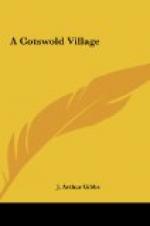ROTAS
OPERA
TENET
AREPO
SATOR
It will be noticed that these five words, the meaning of which is, “Arepo, the sower, guides the wheels at work,” form a kind of puzzle; they may be read in eight different directions.
A large variety of sepulchral urns have been found at Cirencester. When dug up they usually contain little besides the ashes of the dead, though a few coins are sometimes included. There is a very perfect specimen of a glass urn—a large green bottle, square, wide-mouthed, and absolutely intact—in this collection. It was found, wrapped in lead and enclosed in a hollow stone, somewhere near the town about the year 1758.
A fine specimen of a stone coffin is likewise to be seen. When discovered at Latton it was found to contain an iron axe, a dish of black ware of the kind frequently discovered at Upchurch in Kent, a juglike-handled vase of a light red colour, and some human bones.
The various kinds of pottery in the Corinium Museum are interesting on account of the potters’ marks found on them. There must be considerably over a hundred different marks in this collection, chiefly of the following kind:—
Putri M. (Manu Putri), by the hand of Putrus.
Mara. F. (Forma Marci), from the mould of Marcus.
Olini Off. (Officina Olini), from the workshop of Olinus.
The museum contains many good specimens of iron and bronze implements, as well as coins and stonework, and is well worthy of the attention bestowed on it, not only by antiquaries, but by the public at large.
At a place called the Querns, a short distance from the town, is a very interesting old amphitheatre called the Bull-ring. This is an ellipse of about sixty yards long by forty-five wide; it is surrounded by mounds twenty feet high. Originally the scene of the combats of Roman gladiators, in mediaeval times it was probably used for the pastime of bull-baiting, a barbarous amusement which has happily long since died out.
Amphitheatres of the same type are to be seen at Dorchester, Old Sarum, Silchester, and other Roman stations.
Mr. Wilfred Cripps, C.B., the head of a family that has been seated at Cirencester for many hundreds of years, has an interesting private collection of Roman antiquities which have been found in the neighbourhood from time to time. He has quite recently discovered the remnants of the Basilica or Roman law-courts.
Turning to the place as it now stands, one is struck on entering the town by the breadth and clean appearance of the main street, known as the market-place. The shops are almost as good as those to be found in the principal thoroughfares of London.
I have spoken before of the magnificent old church. There is, perhaps, no sacred building, except St. Mary Redcliffe at Bristol and Beverley Minster, that we know of in England which for perfect proportion and symmetry can vie with the imposing grandeur of this pile, as seen from the Cricklade-street end of Cirencester market-place.




